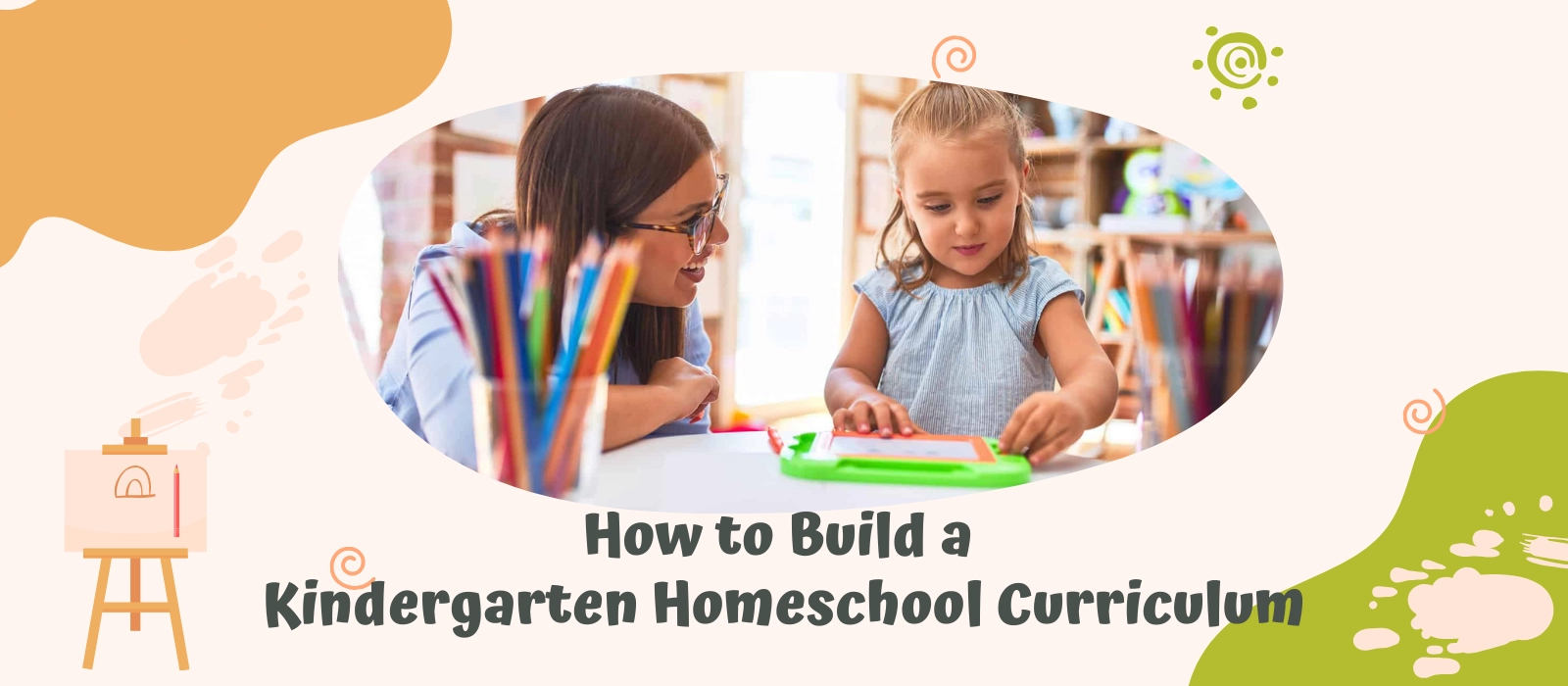Introduction
Are you overwhelmed trying to create a kindergarten homeschool curriculum from scratch? Wondering how to balance fun and structure, or worried your child might fall behind without formal schooling? Do you feel lost choosing the right materials, methods, or even furniture for your learning space?
Yes, you can absolutely build an effective kindergarten homeschool curriculum—even without a teaching degree. All it takes is a clear framework, age-appropriate materials, and a flexible mindset. With a bit of planning and the right environment, your home can become a joyful space for learning, discovery, and growth.
A strong start sets the tone for everything that follows. So let’s break this down: what actually goes into building a functional, joyful, and effective homeschool curriculum for kindergartners?
1. Understanding the Basics of Kindergarten Homeschool Curriculum
Before jumping into specific lesson plans or learning materials, it’s important to understand the foundation of a kindergarten homeschool curriculum. At its core, kindergarten isn’t about pushing children into academics early—it’s about laying the groundwork for how they approach learning for the rest of their lives. That means focusing on the whole child: cognitively, emotionally, socially, physically, and creatively.
In most formal education systems—whether in the U.S., Canada, or across Europe—kindergarten programs aim to promote five major areas of development:
- Language and Literacy: Developing vocabulary, communication skills, basic reading readiness.
- Cognitive Development: Recognizing numbers, problem-solving, patterns, and basic logic.
- Social and Emotional Skills: Learning cooperation, sharing, self-regulation, and empathy.
- Physical Development: Building gross and fine motor skills through movement, play, and hands-on tasks.
- Creative Expression: Nurturing imagination through music, drawing, building, and dramatic play.
A good homeschool curriculum should cover all these domains, but it doesn’t have to look exactly like a traditional school classroom. In fact, one of the advantages of homeschooling is that it can be far more tailored to the child’s natural rhythm and interests.
Educational frameworks like Montessori, Waldorf, Reggio Emilia, and Charlotte Mason all influence how parents structure their homeschool approach. Some families follow an established philosophy closely, while others build their own system using the best parts of each. In North America, many states or provinces also offer guideline documents or core standards that you can use as a reference to ensure you’re covering age-appropriate skills.
Another essential element is understanding how young children learn. At age 4 to 6, kids thrive on routine, repetition, and play-based exploration. This means your curriculum should be predictable yet flexible, with consistent morning and afternoon rhythms, time for movement, quiet reading, hands-on discovery, and guided interaction.
A homeschool curriculum doesn’t just include what you teach—it also includes where and how you teach. That’s why your physical setup at home matters. Whether it’s a full learning room or a cozy corner with a child-sized table, environment impacts attention, independence, and comfort. At XIHA Furniture, we’ve worked with thousands of educators and parents to help create child-friendly learning environments using safe, durable, and affordable furniture.
To summarize, building a solid kindergarten homeschool curriculum starts with:
- Knowing the five pillars of early childhood development
- Choosing an educational framework (or mixing a few)
- Structuring your day to match how young children learn
- Creating a space that invites exploration and supports independence
2. Key Components of a Solid Kindergarten Homeschool Curriculum
Once you understand the basics of a kindergarten homeschool curriculum, the next step is to assemble its essential building blocks. A well-rounded curriculum balances structure and flexibility, offering daily variety while anchoring children in predictable routines. The best kindergarten homeschool curriculum provides a combination of academic exposure, emotional nurturing, physical movement, and creative exploration.
Let’s explore what makes a kindergarten homeschool curriculum effective:

1. Literacy Activities
Daily reading is a cornerstone. Incorporate read-aloud sessions, phonics games, alphabet tracing, and story sequencing. These help develop pre-reading and comprehension skills. Use age-appropriate books, flashcards, and storytelling prompts to boost vocabulary and imagination.
2. Math Concepts Through Play
Introduce numbers, shapes, patterns, and measurements using hands-on activities. Use puzzles, counting bears, sorting bins, and nature-based math games. Tactile learning is essential at this age, and math manipulatives make abstract concepts easier to grasp.
3. Science Exploration
Children are naturally curious. Encourage observation, prediction, and experimentation with simple science projects: planting seeds, mixing colors, or testing float vs. sink. Integrate nature walks and sensory bins to awaken scientific thinking.
4. Art and Creativity
Art nurtures emotional intelligence. A strong kindergarten homeschool curriculum includes drawing, painting, cutting, collage-making, and music. Let children explore with different media, celebrate their creativity, and connect learning to self-expression.
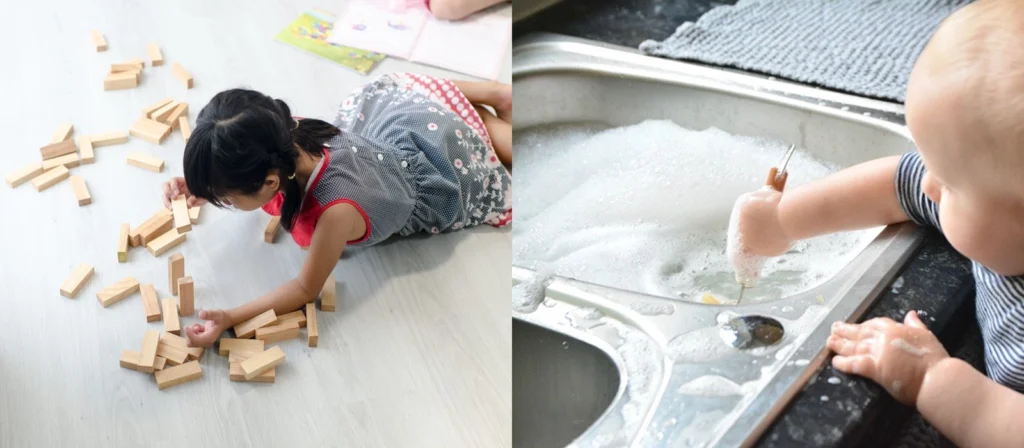
5. Gross and Fine Motor Development
Active bodies build healthy minds. Plan daily movement sessions: yoga, dancing, obstacle courses, and outdoor play. For fine motor practice, include bead-stringing, clay modeling, scissor use, and building blocks.
6. Social and Emotional Learning (SEL)
Even in a homeschool setting, SEL is crucial. Use role-play, emotion cards, and reflection circles to build empathy, patience, and cooperation. Acknowledge feelings and model respectful communication.
7. Thematic Units and Cross-Curricular Activities
Many effective homeschoolers organize lessons around themes like “seasons,” “community helpers,” or “animals.” This approach helps connect literacy, math, science, and art into an immersive learning experience.
8. Practical Life Skills
Inspired by Montessori practices, teach everyday skills: pouring water, folding clothes, preparing snacks. These not only build independence but also enhance motor control and focus.
9. Environment and Materials
The learning space is just as important as the lesson content. Flexible seating, child-sized furniture, and accessible shelves empower kids to engage independently.
Ultimately, an effective kindergarten homeschool curriculum is more than a set of worksheets. It’s a living, adaptable system that grows with your child and reflects their unique strengths. With consistent effort, the right tools, and a bit of creativity, any parent can build a nurturing and effective home learning environment.
3. Choosing the Right Educational Philosophy for Your Child
Choosing the right educational philosophy is a crucial step in designing a successful kindergarten homeschool curriculum. While some families thrive with a structured, academically-driven schedule, others flourish in a more relaxed, child-led environment. There is no one-size-fits-all approach. The beauty of homeschooling is that it allows you to tailor your curriculum to your child’s personality, pace, and interests.
Let’s take a closer look at some of the most influential educational philosophies and how they shape the kindergarten homeschool curriculum:
Montessori
A Montessori-inspired kindergarten homeschool curriculum emphasizes hands-on learning, independence, and real-life skills. Children are seen as naturally curious and capable. The curriculum is usually arranged in activity centers, allowing the child to choose their work. Materials are self-correcting and designed to develop fine motor skills, order, concentration, and responsibility.
Ideal for: Children who are independent, focused, and thrive in a calm, orderly environment.
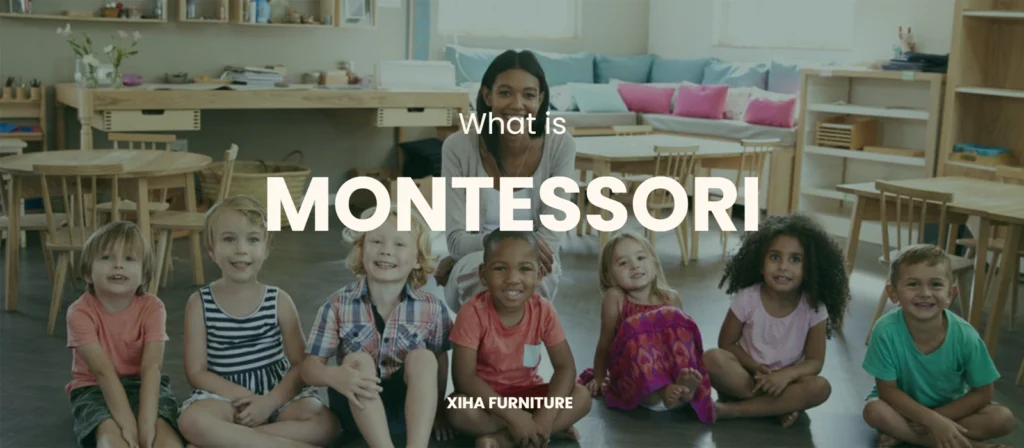
Waldorf
The Waldorf approach centers on imagination, routine, and a connection to nature. The kindergarten homeschool curriculum here avoids early academic pressure and emphasizes storytelling, art, music, and seasonal rhythms. It values the whole child—head, heart, and hands—equally.
Ideal for: Families who value creativity, slower-paced days, and rich sensory experiences.
Reggio Emilia
This philosophy treats the environment as the “third teacher.” It places high value on self-expression, exploration, and documentation. A Reggio-inspired kindergarten homeschool curriculum might involve project-based learning and emergent curriculum—lessons shaped around the child’s interests.
Ideal for: Curious and expressive children who love exploring ideas in depth.
Charlotte Mason
Known for its emphasis on literature and habit training, a Charlotte Mason kindergarten homeschool curriculum includes reading “living books,” nature study, art appreciation, and short, focused lessons. It also incorporates personal responsibility and character development.
Ideal for: Families who value classic literature, nature, and moral education.
Eclectic or Mixed Approach
Many homeschoolers choose not to commit to one philosophy but instead borrow elements from each. This flexibility lets you respond to your child’s changing needs. For example, you might use Montessori materials for math, Waldorf storytelling for language arts, and Reggio Emilia techniques for science and inquiry.
Ideal for: Parents seeking a customized approach based on what works best for their child.
When selecting a philosophy, ask yourself:
- What learning style does my child prefer?
- How much structure does our household need?
- Do we want more teacher-led or child-led experiences?
- What aligns with our family values?
There’s no wrong choice—only what’s right for your family. The goal is not to be perfect but to be intentional. A thoughtfully chosen approach can give your kindergarten homeschool curriculum both direction and depth.
4. What Furniture and Supplies Do You Actually Need?
Designing an effective kindergarten homeschool curriculum doesn’t stop at lesson plans and teaching styles—it extends to the environment and tools you provide. A child’s learning experience is deeply shaped by their surroundings, which is why it’s essential to choose furniture and supplies that support independence, safety, and creativity.
Learning Zones and Layouts
Your homeschool setup doesn’t need to mimic a school classroom, but creating clear zones for different activities helps structure your child’s day. Consider organizing your space into these basic zones:
- Reading and Quiet Area: A cozy nook with a small bookshelf and cushions
- Creative Corner: A table with art supplies like crayons, glue, scissors, and paper
- Practical Life Station: Low shelves with trays for tasks like pouring, sorting, or folding
- Hands-on Learning Space: Table or floor space for puzzles, blocks, and science activities
These defined areas signal to the child what type of activity to expect, increasing focus and flow during the day.
Child-Sized Furniture
Preschoolers need furniture that suits their scale. A child-sized table and chairs encourage proper posture, autonomy, and comfort. Avoid adult-sized setups that may feel intimidating or limit movement. A good table should be sturdy, wipeable, and proportionate to your child’s height.
Storage is equally important. Use open shelving systems so children can see and reach materials independently. Clear bins or labeled baskets foster organization skills and responsibility.
If you’re looking for high-quality, child-safe, and affordable preschool furniture, XIHA Furniture offers a wide range of modular furniture tailored to homeschool and early education settings. As a factory-direct supplier with extensive export experience, XIHA Furniture ensures safety, functionality, and value—especially for families and educators who want durable solutions without overspending.
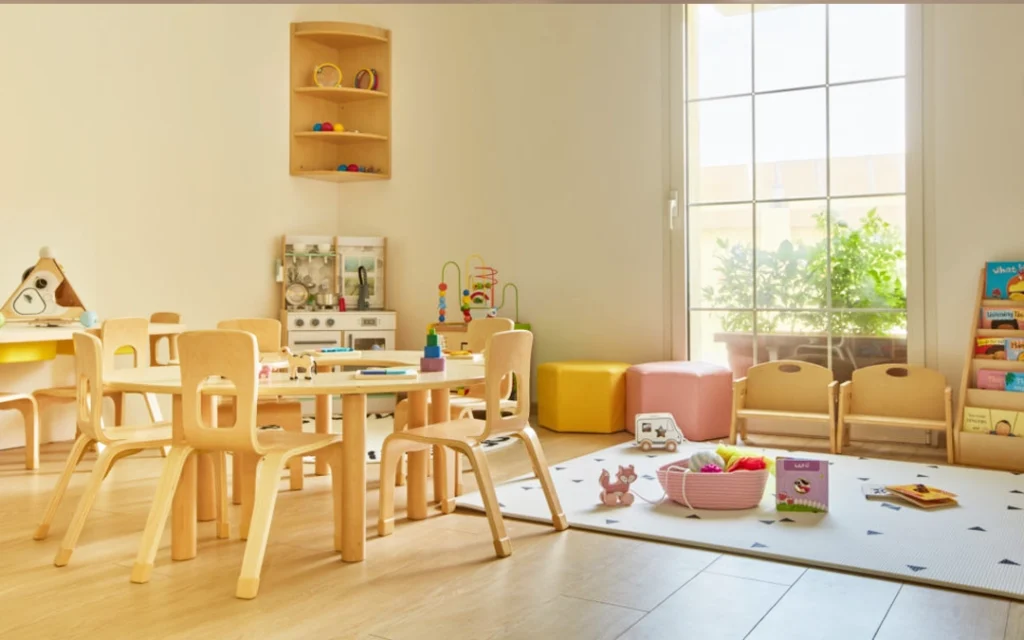
Essential Supplies
A well-equipped kindergarten homeschool curriculum calls for basic yet high-quality materials:
- Art supplies: markers, colored pencils, glue sticks, safety scissors, watercolor paints
- Math manipulatives: number tiles, counting bears, shape sorters, abacuses
- Literacy tools: alphabet cards, storybooks, dry erase boards, magnetic letters
- Science tools: magnifying glass, nature journal, sensory bins, seed trays
- Fine motor tools: tweezers, beads, pegboards, playdough
Quality over quantity is key. Rather than overloading with options, rotate materials every couple of weeks to keep interest high.
Outdoor Additions
If possible, include outdoor elements in your kindergarten homeschool curriculum. Sand tables, nature collections, balance bikes, or gardening tools all promote motor development and observational learning.
Ultimately, the best homeschool space is one that adapts to your child’s evolving interests and needs. It should invite curiosity, feel safe, and offer enough freedom for your child to take ownership of their learning journey.
5. Building Daily and Weekly Schedules That Engage Children
Even the most thoughtfully designed kindergarten homeschool curriculum can fall short without a solid routine. Young children thrive on consistency. Predictable daily and weekly schedules offer them a sense of security, reduce anxiety, and make transitions smoother. But at the same time, schedules should be flexible enough to respond to your child’s interests and natural rhythms.
Designing a Daily Rhythm
A typical day in your kindergarten homeschool curriculum should include a mix of active and quiet time, teacher-guided and self-directed activities. Consider using the following structure:
- Morning Circle Time: Songs, weather discussion, calendar, sharing thoughts
- Literacy Block: Read-aloud, phonics games, writing practice
- Snack & Movement Break: Short outdoor activity or yoga session
- Math & Logic: Counting games, hands-on math, puzzles
- Creative Time: Arts and crafts, music, dance
- Lunch & Free Play: Restorative, child-led
- Afternoon Focus: Science exploration, nature walk, practical life skills
- Wrap-Up Routine: Story time, review of the day, clean-up
The goal is not to replicate a strict school schedule but to create a reliable rhythm that helps kids feel grounded while leaving room for spontaneous joy.
Weekly Thematic Planning
To add variety and keep engagement high, many parents organize their kindergarten homeschool curriculum around weekly or bi-weekly themes. A theme like “farm animals” or “space” can drive reading material, crafts, science experiments, and even movement games. Themes make learning more meaningful and help children make connections across subject areas.
Here’s an example of a weekly theme schedule:
- Monday: Introduce theme and key vocabulary
- Tuesday: Related reading and literacy activity
- Wednesday: Science experiment or exploration
- Thursday: Art project tied to the theme
- Friday: Review, presentation, or pretend play
Tools to Keep You on Track
Use visual schedules with pictures and symbols for young learners. This promotes independence and helps non-readers follow along. Weekly planning sheets, checklists, or digital tools like Google Calendar can help you stay organized as the parent and teacher.
Adjusting Based on Your Child
Every child is different. Some children need more breaks, others thrive with long blocks of deep focus. Observe how your child responds to certain times of day, subjects, and transitions. Adjust your kindergarten homeschool curriculum accordingly. Remember: flexibility is a strength, not a weakness.
A well-balanced routine does more than fill time—it creates rhythm, reinforces learning, and builds positive habits that last a lifetime.
6. Teaching Tips for Non-Teacher Parents
One of the biggest fears parents face when starting a kindergarten homeschool curriculum is: “Am I qualified to teach my child?” The answer is yes. You are your child’s first teacher, and with the right mindset and tools, you can confidently guide their learning journey.
Start with a Growth Mindset
You don’t need a teaching degree to be an effective educator. What you need is a willingness to learn, adapt, and grow alongside your child. View challenges as opportunities to model resilience. Your attitude toward mistakes will shape how your child handles them, too.
Keep Lessons Short and Engaging
Young children have short attention spans. Aim for 10-15 minute blocks per subject, especially for focused tasks like phonics or math. Use songs, stories, hands-on materials, and movement to keep things lively. Rotate between active and calm activities to maintain energy levels.
Use Everyday Moments as Learning Opportunities
Teaching doesn’t only happen at a table. Use cooking to teach measurement, gardening to introduce biology, and walks to explore nature. Your kindergarten homeschool curriculum becomes more meaningful when it’s woven into real life.
Encourage Exploration, Not Perfection
Avoid over-correcting your child. Celebrate effort and curiosity over “right answers.” Allow mistakes to happen—they’re part of learning. Foster independence by offering choices and giving your child responsibility for small tasks.
Observe and Reflect
Spend time watching how your child learns best. Do they thrive with visuals? Do they love storytelling? Are they most alert in the morning? Use these insights to fine-tune your teaching style and curriculum pace.
Ask for Help When Needed
You don’t have to do it all alone. Lean on homeschool communities, parenting groups, and educational platforms. Online courses, printable worksheets, and video lessons can be valuable additions to your kindergarten homeschool curriculum.
Keep Records—But Keep Them Simple
Document progress through photos, short notes, or simple portfolios. Track what your child is learning and how they’re growing. This builds your confidence and helps you stay aligned with goals.
Homeschooling as a non-teacher parent isn’t about replicating school at home—it’s about creating a nurturing space where learning happens naturally. Trust yourself. Trust your child. And remember, consistency and connection matter more than perfection.
7. Common Pitfalls and How to Avoid Them
Even with the best intentions, many parents stumble when building a kindergarten homeschool curriculum. Recognizing potential pitfalls early can save time, reduce stress, and help create a smoother learning journey for both you and your child.
Mistake 1: Over-Scheduling the Day
One common trap is trying to mimic a full school day at home. Overloading your schedule with back-to-back subjects can lead to burnout—for both you and your child. Kindergarteners need time to play, imagine, rest, and simply be kids. A balanced routine is better than a busy one.
Tip: Focus on quality over quantity. Two to three core learning blocks per day are usually enough at this age.
Mistake 2: Expecting Instant Mastery
Learning is not linear. Children may grasp a math concept quickly one week and struggle with letter recognition the next. Don’t expect perfection or instant results. Pushing too hard can damage confidence and enjoyment.
Tip: Celebrate progress, not just outcomes. Revisit tricky concepts in new ways and give your child time to grow.
Mistake 3: Choosing the Wrong Materials
A kindergarten homeschool curriculum can quickly derail if the materials are too advanced, too boring, or not hands-on enough. Worksheets alone won’t hold a young child’s attention. Nor will abstract lessons disconnected from their everyday life.
Tip: Choose materials that are age-appropriate, tactile, colorful, and play-based. Rotate resources regularly to keep interest alive.
Mistake 4: Ignoring the Learning Environment
The physical space matters. A cluttered, overstimulating, or adult-sized environment can lead to frustration. Children need a dedicated area that is inviting, organized, and scaled to their size.
Tip: Set up simple, defined learning zones using child-sized furniture, open shelves, and calming decor. Keep distractions minimal.
Mistake 5: Comparing to Others
It’s easy to fall into the comparison trap—especially in online communities or when talking with other parents. Every child learns at their own pace, and every homeschool looks different.
Tip: Focus on your child’s unique journey. Use comparison only as inspiration, not a standard to measure against.
Mistake 6: Neglecting Self-Care
Burnout is real. Homeschooling is a full-time job, and when you add parenting, household duties, and possibly work-from-home responsibilities, it’s a lot.
Tip: Schedule breaks for yourself. Even 15 minutes of quiet time can refresh your mindset. Seek support when needed.
Avoiding these pitfalls doesn’t mean you’ll homeschool perfectly—it means you’ll homeschool sustainably. Your kindergarten homeschool curriculum should feel joyful, not stressful. Progress comes with patience, flexibility, and a whole lot of love.
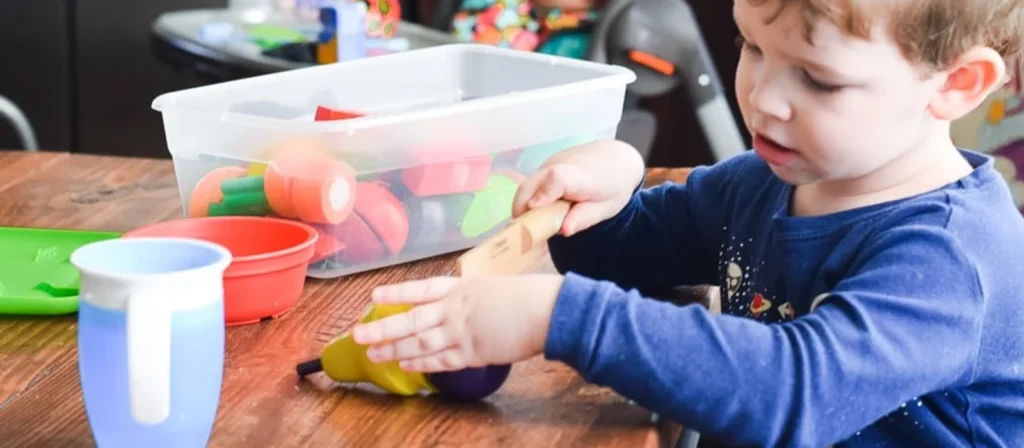
Conclusion
A strong kindergarten homeschool curriculum doesn’t have to be complicated. With the right mindset, thoughtful structure, engaging materials, and a nurturing environment, any parent can create a powerful early education experience at home. Focus on your child’s needs, remain flexible, and enjoy the journey.
If you’re looking for affordable, safe, and functional furniture to support your homeschool setup, XIHA Furniture is here to help. We specialize in manufacturing child-sized furniture that aligns with early childhood development standards—so your learning space grows along with your child.

